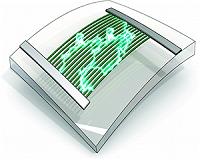 |
Washington DC (SPX) Mar 03, 2010 Random thermal fluctuations in magnetic memory can be harnessed to reduce the energy required to store information, according to an experiment reported in the current issue of Physical Review Letters. The development could lead to computer memory that operates at significantly lower power than conventional devices. Markus Munzenberg of Universit�t Gottingen and Jagadeesh Moodera of MIT describe the potential route to greener magnetic memory in a Viewpoint in the latest issue of APS Physics (physics.aps.org). Heat is usually a problem when it comes to storing digital data. At the microscopic level, the molecules and atoms of anything at a temperature above absolute zero are in constant motion. Because magnetic memory relies on controlling and measuring the orientation of tiny magnetic particles, the jostling that comes about as components warm up can potentially scramble data. Thermal issues are a major concern as researchers build increasingly dense and fast magnetic memory. But heat isn't entirely bad, according to a collaboration of Italian and American physicists that has shown that random thermal motions can be helpful for writing magnetic data. Essentially, they found that applying an electrical current that should be too modest to record data can still be effective for writing information because thermal motion gives an added boost to help orient magnetic particles. The researchers confirmed the effect by measuring magnetic fluctuations as the particles that make up memory were being aligned. Thermal motions are random, which in turn causes random variations in the amount of time it takes for magnetic particles to line up. The fact that alignment times ranged from one to a hundred billionths of a second made it clear that random, temperature-dependent motion must be at work in helping to flip the particles. The experimental confirmation of the thermal effects on magnetic memory points the way to new, thermally-assisted data writing schemes. The advances could reduce the power required to store information, potentially helping to ensure that future PCs are increasingly green machines.
Share This Article With Planet Earth
Related Links American Physical Society Powering The World in the 21st Century at Energy-Daily.com
 New Material Can Harvest Electricity From Body Movements
New Material Can Harvest Electricity From Body MovementsWashington DC (SPX) Feb 26, 2010 Scientists are reporting an advance toward scavenging energy from walking, breathing, and other natural body movements to power electronic devices like cell phones and heart pacemakers. In a study in ACS' monthly journal, Nano Letters, they describe development of flexible, biocompatible rubber films for use in implantable or wearable energy harvesting systems. The material could be used, ... read more |
|
| The content herein, unless otherwise known to be public domain, are Copyright 1995-2010 - SpaceDaily. AFP and UPI Wire Stories are copyright Agence France-Presse and United Press International. ESA Portal Reports are copyright European Space Agency. All NASA sourced material is public domain. Additional copyrights may apply in whole or part to other bona fide parties. Advertising does not imply endorsement,agreement or approval of any opinions, statements or information provided by SpaceDaily on any Web page published or hosted by SpaceDaily. Privacy Statement |